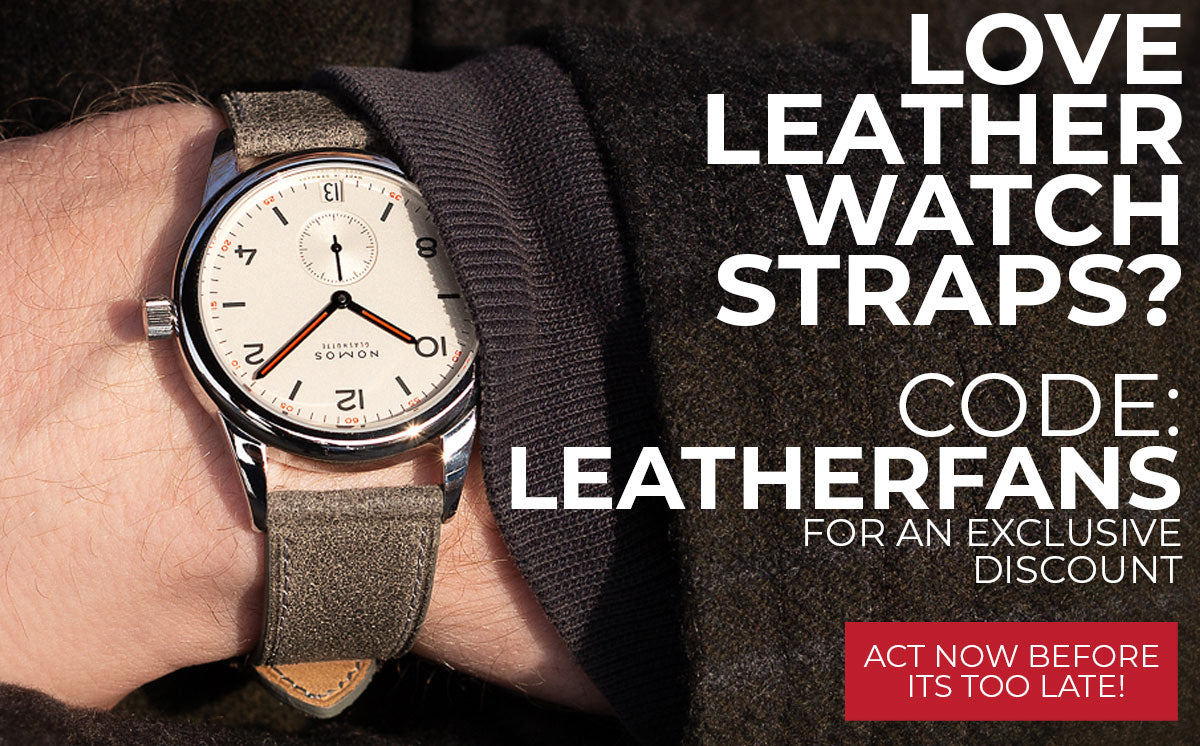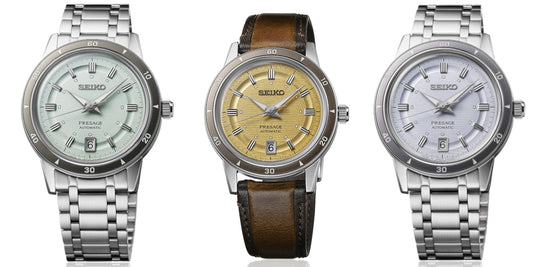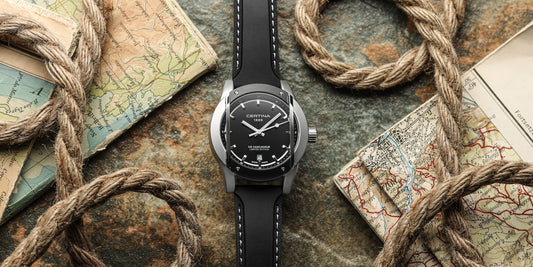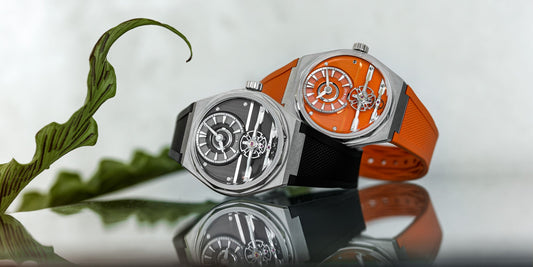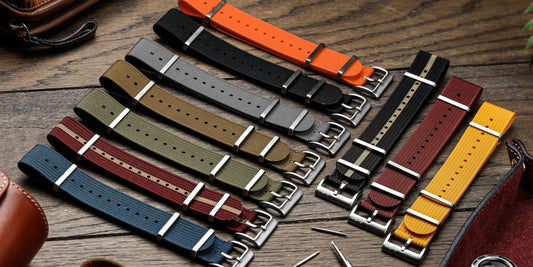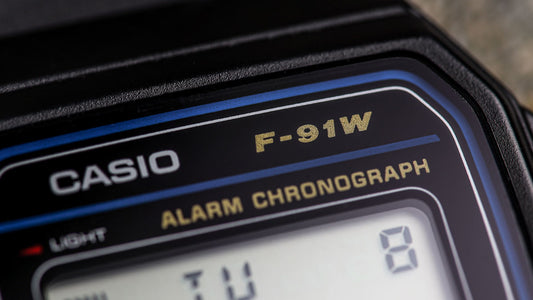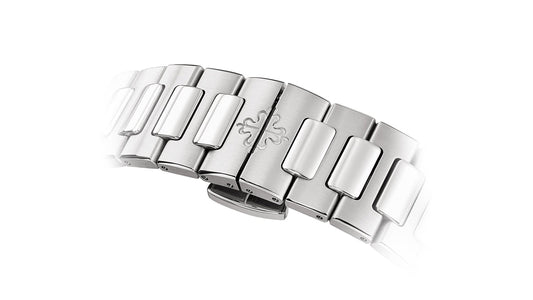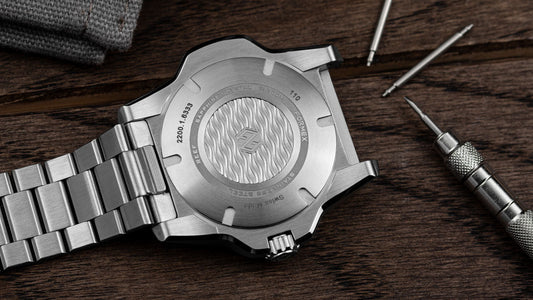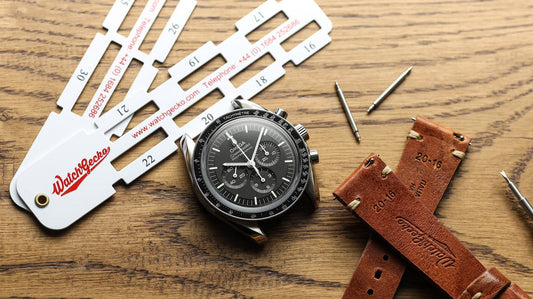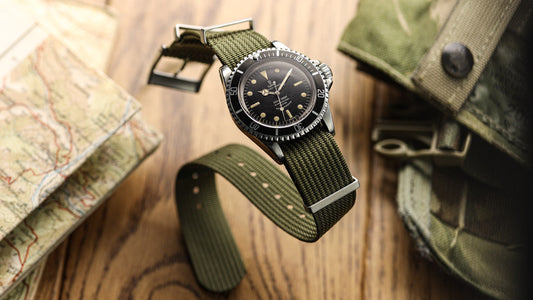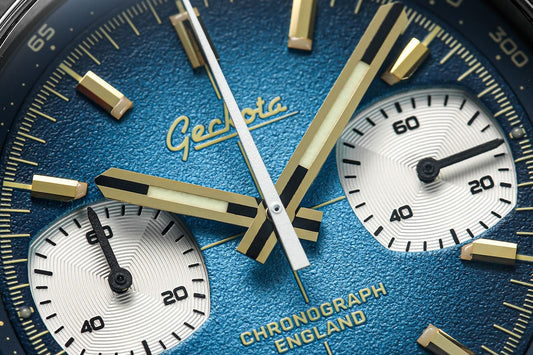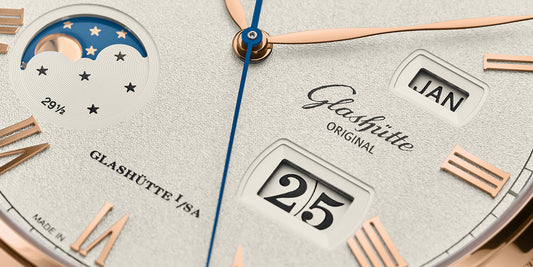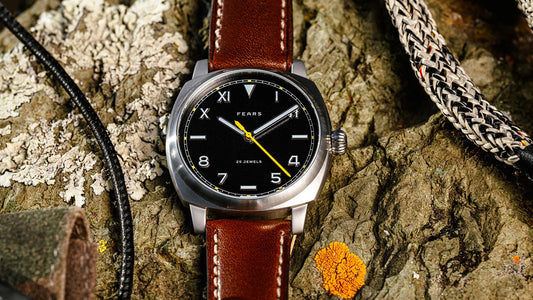Leather watch straps are timeless and stylish. In this article, read all about leather watch bands and get ideas for choosing, buying and using yours…
Imagine strapping on a watch and your mind probably goes to either a metal bracelet or a leather strap of some sort. But when we delve into the microcosm that’s watch straps, and leather watch straps in particular, we find interesting variations. And of course, as with watches themselves, some very interesting history…
It’s kind of mind-boggling to think that the origins of the luxury leather strap on your IWC Mark XVI, Omega Seamaster Aqua Terra or Oris Audi Sport GMT probably go back hundreds of thousands of years. In fact, back to when our distant ancestors started using strips of animal hide to assemble implements – and attach items to their bodies while hunting or foraging.Now jump forwards thousands of years to the late nineteenth century. It’s the eve of the Boer Wars and World War 1 and most men’s timepieces were pocket watches, carried securely within their clothing.
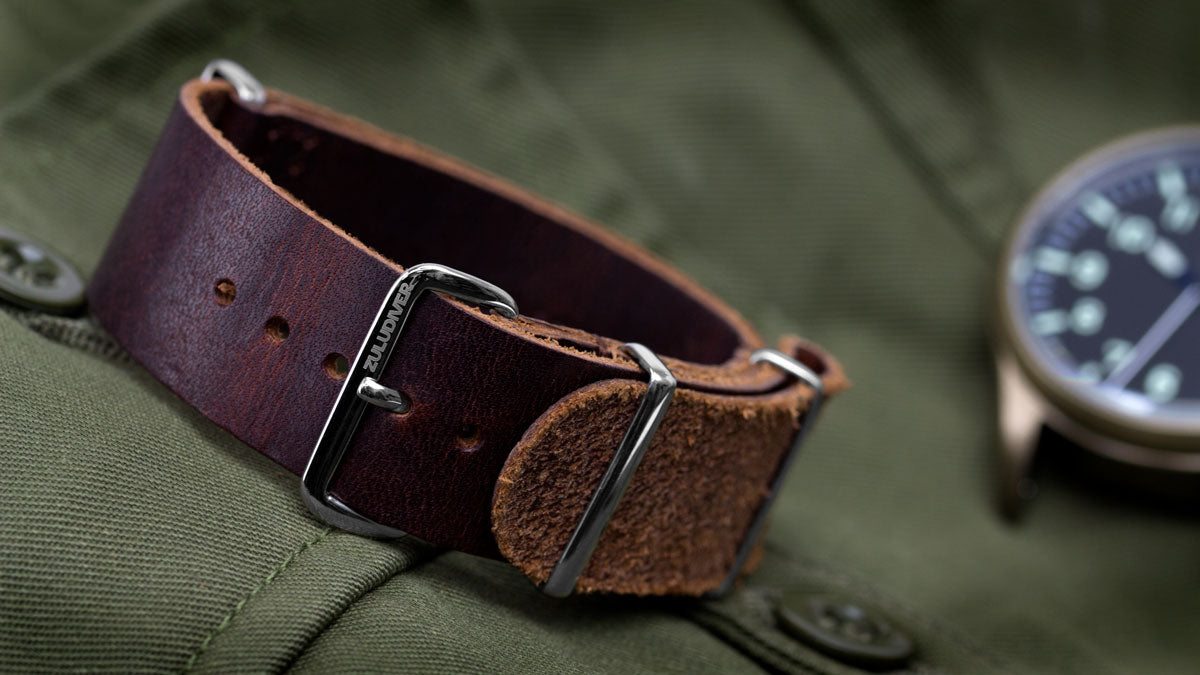
The first leather watch straps
Some sources put the origin of leather watch straps (maybe even the whole concept of watch straps) at the time of South Africa’s Freedom Wars. Contemporary descriptions tell of soldiers discarding jackets and waistcoats in the heat of the Veldt and wearing their pocket watches, on simple leather bands, on their wrists. Other sources put this evolution even earlier, during the Third Burma War of 1885–7. As one commentator says:
Although many watch manufacturers claim to have invented the wristwatch, such a simple thing as strapping a watch to one's wrist didn't actually need to be "invented" – it is obvious.
Whatever the precise chronology, technical and sociological drivers, we know that for various reasons, primarily driven by military requirements at the end of the nineteenth century, this transition started with the then-innovative leather-cup ‘wristlets’ containing ‘Campaign’ watches in Borgel cases.
Among the reasons for a strap would have been protecting the precise mechanism and relatively fragile finish of contemporary watches from ‘hazards’ when removed from the pocket’s protection. Additionally, a broad, ‘manly’ leather holder would have helped overcome male resistance to wearing an ‘effeminate bracelet’. Remember: women had already been wearing wrist watches for years.

Gaining momentum with military demands
Adoption of leather straps gained momentum with the military demands (such as artillery, aviation and accurate co-ordination of mass infantry operations) of WW1. Looking back with the clarity of hindsight, the military one-piece safety-pattern straps of that time were clearly forerunners of 1970s military straps.
And of course, 20 years after the battles of Gallipoli, northern France and Belgium, WW2 saw further evolution of leather straps for military purposes. This included the ill-fated leather straps originally fitted to Elgin Grade 540 and 554 watches (soon replaced with nylon bands after the leather rotted from salt exposure at sea). Then there were the oversized leather bands on Longines watches issued to Czech air force pilots and the waterproofed leather straps on Italian divers’ Panerai. And of course, the extended leather straps specified for WW2’s B-Uhren from Lange und Söhne, Laco, Stowa, Wempe and IWC.
For this article, we’ll focus on genuine leather straps rather than faux leather alternatives. So let’s explore the role of this versatile natural material, starting with a quick reminder about what leather is.

What is leather?
Leather for watch straps is a complex topic with plenty of potential for its own article. For anyone interested in its detailed history and science, lots of reference material is available in hard copy and online.
Leathers are generally subdivided into genuine and faux leathers. Artificial leathers have names such as ‘pleather’, ‘vegan leather’ ‘bicast leather’ and leatherette, as well as proprietary names such as Naugahyde and Alcantara.
Genuine leather is typically made from animal skins: cows, goats, sheep, pigs and equines (e.g. the fabulously expensive shell Cordovan leather named after the Spanish shoemaking city of Cordoba). Historically, and now controversially because of environmental and animal rights sensitivities, hides from creatures such as alligator, crocodile, lizard and other ‘exotics’ were widely used.
Nowadays, embossing means the surface textures and appearance of these leathers can be faithfully reproduced on straps made from more widely acceptable leathers. The underlying leather is frequently cowhide or calfskin. For instance, Sinn’s 358 SA PILOT comes with what the German watchmaker describes as a ‘cowhide strap with alligator embossing’.
Other finishes and thickness variations are achieved by embossing, punching, stitching and combining multiple layers of genuine (or genuine and faux) leather for the front and lining of a strap. On padded straps, padded cores are sandwiched between layers of leather to give opulent profiled finishes.
Faux leathers come from factories, but genuine leathers are produced in tanneries where hides are treated with natural and synthetic oils, dyes and other surface treatments, texturing and graining. Many different tanning and finishing processes, as well as the addition (or not) of padding (particularly for larger men’s watches) are applied. As well as being dictated by required surface finishes, these are also determined by the type of hide.
A faux or genuine leather watch strap?
Should you choose faux or genuine leather for your watch strap? It’s a very personal decision, but if you’re comfortable with the ethics of animal hides, and you can find one that’s compatible with the environment where you’ll use it (for instance, in water or humid environments), we’d say go genuine where you can. Ultimately, the choice is yours.
However, as we’re thinking about the use of leather watch straps for tool watches such as divers, it’s worth bearing the following in mind. With so many high-quality straps available in various natural materials and synthetics, it’s not expensive to put a leather strap on your Sub, Seamaster or even a classic DOXA. You could then switch to a stainless steel bracelet, or a functional Italian rubber strap, when you go in the water…

Types of leather watch straps
Leather watch straps come in a vast range of sizes, materials and styles, and at every price point. Let’s look at the main types of leather watch strap. Some work beautifully with many different watch types, while others are better suited to specific types of timepiece.
Later, we’ll look at matching straps to watches for the best appearance and consistency between the strap’s historical origins and the watch’s function. If you love a certain watch and strap combination, just go for it! The main thing to remember (after water resistance) is that the watch head needs removable spring bars (lug bars) for installing an aftermarket strap. Additionally, of course, you’ll need to correctly match the length of the spring bars to the strap width (typically 18 mm for men’s dress watches up to 22 mm or even 24 mm for sports watches).
Here are the types of strap we’ll look at:
- Stitched leather straps
- Rally-style straps
- Perforated leather watch straps
- Bund straps
- Padded watch straps
- Leather Military straps (and ZULU straps)
The widespread availability and reasonable pricing of different leather strap styles from brands like ours means you can easily build a selection of straps to wear with your watches. As we’ll show you later, this is a great way to quickly increase the size and variety of your watch collection.

Stitched leather watch straps
Many genuine leather watch straps are manufactured this stitching leather, usually in conjunction with gluing. Stitched straps find applications ranging from rugged leather bands on budget Invicta Pro Divers, to exquisite hand-stitched alligator leather on high-end dress watches such as the £238,000 (2016) Lange 1 Tourbillon Perpetual Calendar. Leather strap stitching may be by machine, by hand (as on the Lange) or using both processes.
As well as being part of the watch strap’s structure, stitching contributes much to your watch strap’s character and appearance. Gluing and stitching is a traditional way to create double-thickness straps (or lined straps, where leather is backed with material, whether leather or not, having different aesthetic or functional characteristics).
The quality and aesthetics of stitching are vital
The quality and aesthetics of stitching are as important as the leather quality for the durability and appearance of straps. Using matching or contrasting stitching effectively distinguishes a particular strap and provides contrast in the same way as pinstripes on a suit or piping on a seat. Compare, for instance, the cream-on-tan contrast of Panerai’s Luminor 1950 Reference PAM00580 with the closely matched grey stitching and leather on the Luminor Power Reserve Automatic Acciaio (Reference PAM00090).
Strap hardware gives further opportunities to enhance leather straps. Hardware includes buckles, clasps, rivets, staples (1939 Lemania and Eterna watches) and keepers, the loops that manage the strap’s pointed, rounded or squared-off loose end (its ‘tail’). The design, type of material and hardware finish are important to complement the strap’s leather, the watch head’s main and accent colours, and its textures.
Rally-style straps (racing pattern straps)
With such a strong historical connection between horology and motor sport, it’s no surprise that trends in vehicle technology soon found their way into watch strap design.
Characteristics inspired by today’s automotive and motor sport technology already involve high-tech ceramics and carbon fibre composites.
The trends from the 1960s and 1970s (arguably a golden age of motor sport) may seem very low-tech now, but they’ve left a mark on watch strap design. Back then, race and rally cars, the circuits they raced on and the drivers’ equipment were very different to today’s. Leather driving gloves (with knuckle cut-outs and finely perforated fingers) and ventilated seat panels were de rigour. Their role? To help dissipate the considerable heat generated in racing car cockpits and make life slightly more comfortable for drivers and navigators in events ranging from the Targa Florio to The Monte Carlo Rally..

The trend peaked in the 1960s and 1970s
At the same time, metal components in race and rally cars (including chassis parts, pedals and steering wheels) drew on aerospace experience with punched or drilled cut-outs to reduce weight. This trend peaked in the 1960s and 1970s with the appearance of leather and metal-bracelet rally (or ‘rallye’) watchstraps from brands such as Tissot. Their cut-outs, albeit more for appearance than function, were a clear nod to similar details on competition cars.
Decades later, the style lives on. As well as a wide range of leather rally-style straps, the bracelets of Tissot’s 2006 PRS Chrono Valjoux, and Breitling’s Air Racer acknowledge classic aerospace and automotive cut-outs.
Overlap between rally-style and perforated straps
As far as we can ascertain, there’s considerable overlap between ‘perforated’ watch straps and ‘rally straps’, with the terms effectively meaning the same thing. Reference to the historical evolution of racing gloves and sports seats reveals widespread inclusion of small perforations in seatbacks and seat cushions, as well as glove fingers where the perforations complement larger cut-outs elsewhere on the glove. Ultimately, this aspect of glove design, which is reflected in the straps of watches such as the Oris Chronoris, is about ventilation and cooling.
Great on larger watches and chronographs
Rally straps look especially good on larger watches, particularly chronographs with their strong motor-racing and aviation associations. They’re often cooler in hot weather than a solid strap. Therefore, they bring practical benefits as well as affectionate homage to past ages of motorsport and aviation. However, we’d also counsel caution before you adopt the 1970s Monza, Spa-Francorchamps or Monaco pit-lane look – large cut-outs may overwhelm smaller, subtler watches such as some mid-size and ladies’ timepieces.
Bund straps (or Bund pads)
Bund watch straps are broad backing straps, typically made of leather, to which a watch head, and sometimes the watch’s thinner main strap, are attached. Bund straps may be either single-piece straps or two-piece straps secured by rivets, tabs or spring bars.
Although such leather straps have been used for well over a century, the ‘Bund’ descriptor most likely comes from the mid-1950s. Specifically, it almost certainly dates from the formation of Germany’s Federal Armed Forces (Bundeswehr). Other sources suggest that Bund straps were widely adopted by the German military from the 1960s onwards, before gradually finding their way into the watch strap mainstream.

Origins of the term in the mid-1950s
Ironically, as far as we know, and despite its name, the German Federal Navy’s 1980 IWC Ocean Bund diver’s watches didn’t come with Bund straps. A photograph of the range, in van der Meijden, Dohrmann and Goerter’s 2009 article in Horological Journal, confirms this. In fact, the IWC Ref. 3519 Ocean Bund came on either a Velcro or Titanium strap. The name appears to be linked to the armed forces' procurement rather than strap type. Whether any were later re-strapped with a Bund, or any other type of leather strap, is unknown.
Although Bund also translates into English as ‘band’, the origin of the Bund name and first appearance of the word Bundeswehr was in 1956. This appears to contradict theories that German WW2 pilots’ widened straps were called ‘Bund straps’. That’s not to say broad straps weren’t used in WW2, but that as far as we can establish they weren’t called Bund straps at the time and have only been given this descriptor retrospectively. Of course, if you know different, do tell us.
‘Bund-style’ straps in WW1 and earlier
Regardless of when the term ‘Bund strap’ was coined, straps of this type date back to at least WW1. These include the Pershing strap on the Pershing Trench Watch. They may have been around even earlier because, as mentioned earlier, pocket watches were being converted into early wristwatches or wristlets by the end of Victorian times.
Later, as aviation developed, pilots probably started using padded straps. Various theories have been proposed for this. Firstly, the obvious one that, as for ground troops’ watches, the wide backing helped the transition from pocket watch to wristwatch. It’s also been suggested that ‘Bund-type’ straps provided insulation against the heat of cockpit fires or extreme cold during high-altitude flight if the watch was worn against the skin. Given that aviation watches often had extended leather straps for wearing over (warm) flying clothing, the insulation argument seems questionable. The simple requirement to accommodate a large diameter watch on the wrist, though less dramatic, seems more plausible.
Another suggestion is that they were worn to avoid the large 'onion' or 'pumpkin' crowns of aviation watches’ digging into the skin when the wrist was flexed. This might have some validity as a large crown on a large watch could do this – but again, wearing these watches over flying jackets would rule this out. However, more recently, a Bund watch strap could be expected to help with the large crowns on many modern divers’ watches or pilot chronographs if they're being worn on an uncovered wrist.
Where are the WW2 Luftwaffe’s ‘Bund’ watches?
Interestingly, and again we’re prepared to be corrected, our search for online images, as well as desk research in numerous reference books revealed surprisingly few instances of ‘Bund-type’ straps. As well as images online, sources included the following: Wesolowski’s A Concise Guide to Military Timepieces; Klaus Häberlen’s autobiographical A Luftwaffe Pilot Remembers; IWC Schaffhausen: Engineering Time Since 1868; historical notes in manufacturer’s catalogues and the ‘Aviator Watches’ chapter in Martin Häussermann’s1001 Wristwatches. None reveals any WW2 Fliegeruhren mounted on what we now call ‘Bund’ straps’. Interestingly, the original Reichs-Luftfahrtministerium designs for Beobachtungsuhren don’t show Bund-type straps – but double-riveted extended leather bands that were 25mm wide at the watch end.
A third possibility, dating back to the earliest days of wristwatches in the late nineteenth and early twentieth century, is that early wide bands protected watches’ thin chrome plating from discolouration against the skin...
Regardless of the origins and chronology of Bund straps, they now enjoy a following, albeit not on the same scale as conventional watch straps.

How to wear your Bund strap
As ever, opinions vary on how best to wear a Bund – and the best watches to match it with. In particular, schools of thought are strongly polarised about wearing these (or any leather strap) with divers’ watches.
So what kind of watches work best? At least one commentator suggests pilot and military style watches by the likes of Stowa, Laco, Hamilton and IWC. We’d add Panerai too, with its proud military tradition. At risk of being controversial, our customers’ experience suggests that divers, ranging from luxury Subs and Seamasters to Steinhart and Orient homages, do work with leather straps – be they contemporary straps such as our Flight Tan Bund or leather ZULU bands.
One thing’s certain in our book: if you like the look and feel of a Bund strap, and understand that it may be ‘warm on the wrist’ on hot days, you should trust your instincts. You’ll be in good company: high-profile wearers include Ed Sheeran, Eric Clapton and David Beckham.


